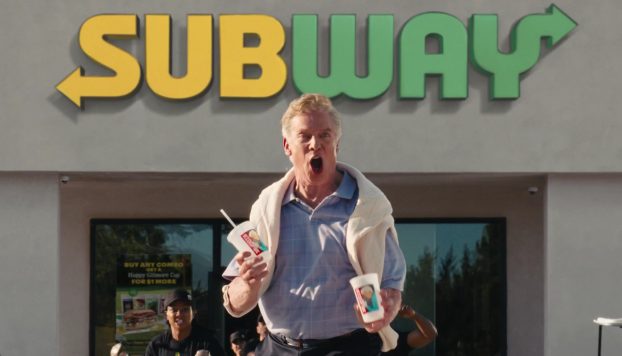Mellow jazz played by a live trio wafts from a sunny, flower-filled mezzanine. Relaxing at umbrella-topped picnic tables, customers snack on savoury sushi, crisp salads, prepared-to-order deli sandwiches, just-out-of-the-oven pizza and piping-hot pastries with cappuccino.
Nearby, a garrulous chef conducts a cooking class in a glass-fronted room that will soon be vacated to make way for a community group meeting.
Below, a studio photographer coaxes a smile from a squirming tot who’d clearly prefer playing a video game
in the colourful Kids Station across the way.
An aisle over, a comely damsel beneath a pyramid of white umbrellas accepts a spritz of famous perfume from a white-coated cosmetics consultant.
The scent drifts toward a couple perusing an array of elegant bed and bath accoutrements, including a towering wall full of multicoloured towels, while a family group debates the merits of a full range of small appliances, tableware and cooking equipment.
Not far away, a well-dressed matron in a bucolic garden setting selects a $40 orchid plant, while her hubby tries out a $600 leather chair with matching ottoman.
Behind them, people are choosing wine, pricing TVs and other electronic items, punching numbers into an ATM and picking up dry-cleaned clothes.
And, oh yes, folks are also shopping for groceries – because this is the supermarket of tomorrow, a ‘destination centre’ that has already arrived in some cities and is on its way to others, in Canada and elsewhere.
This store happens to be a Loblaws that opened in Markham, Ont., near Toronto, about six months ago. At 115,000 square feet, it’s easily three times as big as the average supermarket and arguably 10 times more attractive.
It has high ceilings, natural light spilling from multiple, atrium-level windows and a host of sophisticated displays and other elements that perceptually divide the huge space into about a dozen stores-within-a-store. These effects also subliminally impart a sense of abundance and entitlement.
More to the point, at least from its proprietors’ point of view, is that in addition to food this Loblaws offers a multitude of merchandise and services for which time-starved consumers usually have to trudge all over town – enriching many retailers along the way instead of just one.
True to Loblaw’s status as the Canadian market leader, the Markham store – unlike stores run by the Fortinos, Dominion and Sobeys chains, which are all currently scrambling to catch up – is definitely a full-frills place. And its myriad of lush exhibits and displays, by Toronto-based design/marketing firm of record Perennial, were introduced to provide not only the convenience of one-stop errand running, but something much more ambitious: a psychological replication of the good life in the congenial village depicted on a giant mural on its back wall.
Contributing to this impression are other in-store design elements: subtle lighting effects, dramatic signage on marquees, banners and walls, plus vivid photo panels of produce and products that reinforce the village market feel. Differing wall colours, flooring materials and half-walls divide the sections.
Bordering the vast produce, deli and HMR (home meal replacement) section is a plantation-style wall with shuttered windows containing potted topiaries. On the other side is a natural foods section complemented by earthy tones and textures. On the other side of that, the products in the health and beauty section visually pop thanks to under-shelf fluorescent lighting.
A row of vertically placed wheat sheaves beckons shoppers to the pioneer-style wooden bakery shelves. Pagoda-like umbrellas atop quaint trolleys, variously containing produce, nuts and antipasti, evoke a feeling of shopping in an exotic bazaar. Drifting overhead are colourful replicas of hot air balloons, while giant yellow tulip clusters revolve above the self-scan checkout stands.
The trend toward ’boutiqueing’ supermarkets in this lavish fashion began in Canada about five years ago, says April Ryan, VP of conventions and expositions at Toronto-based Grocery Innovations Canada, which will stage its second annual exposition in Vancouver next month.
Ryan says GIC’s first expo, which drew a whopping 800 exhibitors to Toronto last October, represented many of the dynamics currently in play in Canada’s $64-billion grocery industry. The consensus? ‘As [famous retail consultant] J’Amy Owens said in her keynote speech,’ Ryan recalls, ‘the supermarket experience is no longer just about people buying food.’
It’s not just about extending the average shopping stint from its current 22 minutes either, according to Ryan and other industry commentators. Nor is it just about nudging shoppers into more sections than the 50% they currently visit, or boosting their impulse buys from the current average of 25 cents on the dollar, or even merely prompting the purchase of more items than are scribbled on the average shopping list.
For the biggest players in the supermarket game, the key strategy is creating memorable in-store experiences that will keep adult consumers returning in the short run and build future brand loyalty among youngsters like that squirming tot in the photo studio.
‘It’s called ‘experiential marketing,” says Phil Lempert. Popularly known as the ‘Supermarket Guru,’ the California-based author and newsletter publisher is the food trends editor and correspondent for NBC’s Today Show.
In Lempert’s opinion, what supermarkets like the Markham Loblaws – and the best of those he sees elsewhere – are actually doing is ‘reincarnating the supermarket as a neighbourhood gathering place…and turning food shopping from a chore into a fun experience for the entire family.’
Geoffrey Wilson, Loblaw Companies VP of industry and investor relations, concurs, albeit in a more laconic manner. ‘It’s all about trying, in a very customer-friendly environment, to offer our consumers as many everyday household-needs offerings as possible in [a single] shopping environment.’
Wilson adds that Loblaw recently opened another supermarket duplicating the Markham store’s footprint and merchandising mix in London, Ont., and plans to repeat the exercise in four or five more stores across the country this year.
Loblaw’s plans don’t surprise Ron Harris, a senior partner in the ‘branding for real life’ department at Toronto-based retail design consultancy Watt IDG. The firm used to work with Loblaw and is now involved in design plans for the Longo’s chain, not to mention designing all the packaging for Wal-Mart and Safeway in the United States.
The buzz in the supermarket industry these days, says Harris, is about ‘managing relationships’ with customers, ideally resulting in their life-long loyalty. ‘And the relationships they’re trying to create, with designers in a key strategic role, goes right back to the notion of people actually finding grocery shopping pleasurable and exciting – like they do in traditional market environments such as [Toronto’s] St. Lawrence Market.’
Or even in ancient suqs in the Middle East, adds Martin Kuster, president of Toronto’s Hunter-Straker design firm. Currently in the midst of redesigning the Azizia Panda chain of Saudi Arabian supermarkets, Kuster says it’s as true there as here that ‘the successful marketer is the one that immerses itself in local demographics and psychographics to learn what its customers want and how they’re evolving.’
In Saudi Arabia, Kuster says that means making sure your designs respect national customs. ‘One example is that, when we put children’s playground areas in the stores, we also added private areas for their mothers or nannies to sit and supervise them.’
Of course, the big question is whether all this magical marketing is producing a decent ROI for the supermarket chains that are gambling like high-rollers at a Las Vegas roulette table. But a straight answer is hard to come by.
Asked how happy Loblaw is with the return on whatever chunk of last year’s $1.1 billion building and renovation budget was spent on the Markham and London stores, Wilson says only that ‘We’re very pleased with the results.’
Loblaw should be pleased, says John Torella, senior consultant with the Toronto-based J.C. Williams Group of retail consultants. ‘Certainly it’s paying off judging by their [recently-released 2001 annual report].
‘Those results reflect growing consumer sophistication in grocery shopping habits. Shoppers want more, they want more unique products, they want more differentiated products and that demand is what Loblaw in particular has responded to.’
Whatever profitability results from the reinvention of the supermarket model, it’s evidently an idea whose time has come. In fact a report released last month by Cap Gemini Ernst & Young, entitled ‘State of the Art in Food: The Changing Face of the Food Industry,’ predicted that ‘conventional supermarkets are reaching the end of their life cycle.’
Charles Knight doesn’t agree with that assessment, at least not across the board. ‘Without a doubt, [boutiqued supermarkets] do huge volumes and, yes, they pay off,’ says the partner in retail practice at Toronto-based consulting firm Arthur Andersen.
‘But can you cookie-cut that platform in every single market across Canada? No. It’s a good format for a lot of places but I just can’t see that taking over the whole industry. There are a lot of consumers whose number one priority is still cost consciousness, not one-stop shopping, convenience or upscale design.’
But Watt’s Harris is less equivocal about the viability of boutiqued supermarkets. ‘They will succeed because if you understand human nature, you’ll know that irrespective of how cheap something is at Costco, interaction is as vital a part of the buying experience as your actual purchase,’ he says. ‘Bantering with a butcher who remembers your name is as important as the meat you buy in terms of a shopping experience you want to repeat.’
Supermarket or fun park?
Tooting trains and clucking chickens help make shopping, er, fun
What else is happening in supermarkets? Plenty. Some of the most avant-garde design ideas include:
* The Florida-based Kash n’ Karry chain’s circular stores, where aisles are laid out like wheel spokes to entice shoppers into more sections than they intend to visit.
* Experiments in the U.S. with theatre-style rotating stage sets and elevate-able sections designed to pique shoppers’ interest by constantly changing the merchandise and presentation.
* Also at the research stage, according to Progressive Grocer magazine, are touch-sensitive display screens on the exterior of store windows allowing shoppers to place orders 24 hours a day for subsequent pickup or home delivery; taste-testing kiosks designed like vending machines to encourage food sampling; and ‘virtual store clerks’ appearing on request in hologram form to answer shoppers’ questions.
* Another innovative design trend is to group seemingly disparate items together to serve a theme, such as party-hosting. For instance, the Markham Loblaws features a ‘Celebrate’ centre that contains everything from candles, napkins, gift wrapping and greeting cards to disposable cameras and film.
Still another strong trend, sometimes called ‘shopper-tainment’ or ‘eat-ertainment,’ is providing crowd-attracting exhibits and events such as the following:
* For those who might enjoy watching huge hunks of beef cure, or seeing and smelling coffee roasting, the Texas-headquartered Whole Foods Market chain will provide both come May, when it opens its first Canadian store at Toronto’s tony Hazelton Lanes.
* How about a row of mechanical chickens perched above the eggs? This spectacle can be witnessed at some stores in the Cincinnati, Ohio-based Kroger chain (one of the largest grocery retailers in the U.S., with fiscal 2000 sales of $49 billion). The chickens even draw shoppers by clucking to a fiddle rendition of Turkey in the Straw.
* Kroger also entices people to its huge international cheese islands every half hour or so for a sampling session with booming announcements such as: ‘And now, presenting the cheeses of Canada,’ followed by a few bars of the respective national anthem.
* And whenever misters begin spraying Kroger’s produce, either a simulated thunderstorm or Gene Kelly warbling Singing in the Rain is broadcast over the P.A. system.
* How about the Albert Heijn supermarket chain in the Netherlands? It boosts awareness of its specials by loading them into a tooting model train that circles overhead and stops directly above displays of the advertised items.
* Finally, at least two Kroger stores in Louisville, Ky. kill two chores with one stone by offering half-hour music lessons for small fry – in sound-proof rooms. TP























